|
|
|
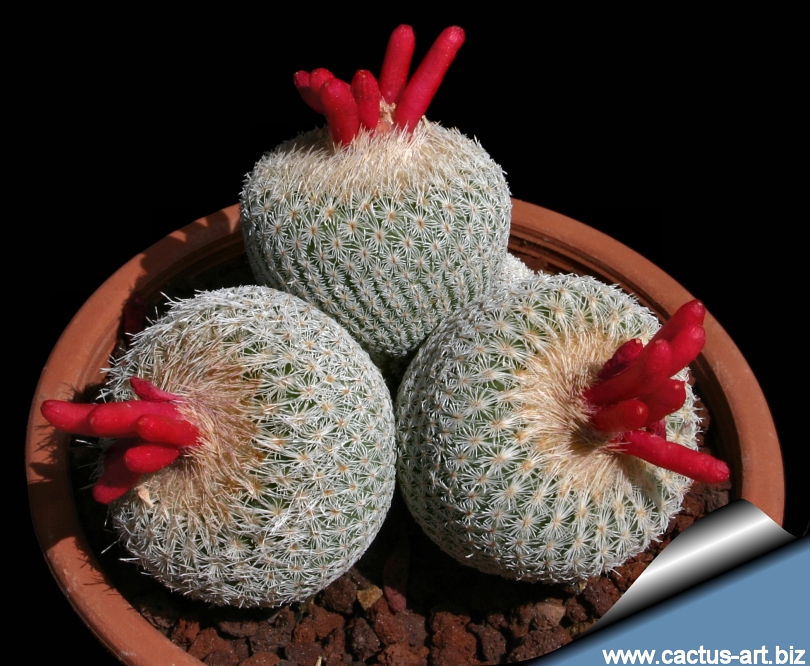
Epithelantha micromeris SB125 Arteagas Canyon, Saltillo,
Coahuila, Mexico
The rather small flowers are often followed by attractive
red fruits
which contrast nicely with the spines
|
|
Description:
Miniature
globose cactus, erect,
unbranched or in small
clumps, not deep-seated in substrate,
appearing ashy grey and relatively rough in general aspect.
Stem:
Unsegmented, mostly
spheric or
obovoidal, rarely cylindric, often flat-topped with a
depressed centre, 1-5(-9)cm tall and up to 2-4 (-7,5) cm in
diameter, occasionally more; surface completely obscured by
spines;
cortex and
pith
are not
mucilaginous.
Tubercles: Numerous, not confluent into
ribs, hemispheric or short cylindric, very small, ca. 1-3
mm; arranged in tight spirals around the plant.
Areoles : Small at tips of tubercles, 1 mm long, nearly
circular, elliptic when distended by flower or fruit, slightly
woolly when young, copiously woolly only at
sexually mature stem
apex;
areolar
glands absent;
Spines: 20-35(-40) white to ashy grey 2-5 mm long,
appressed on sides of stems,
straight,
terete, slender, innocuous, in 1-3
superimposed series except for a longer (4-12 mm) and erect
adaxial tuft on the top,
on
sexually mature stem apex often greyish or purplish white,
frequently with brown bases, collectively
forming brown spots at
the centre of each spine cluster. Spine
clusters at
the sides of stem 4-5(-7) mm
in diameter. Smooth or microscopically
roughened by break-up of
epidermis, not distinguishable as
radial and
central spines.
In fully
adult plants,
the
distal portions of the longest spines are worn, leaving the
apex of the plant covered with short,
innocuous spines.
Roots:
Diffuse (usually) or
tap-root (in some
populations)
also
tuberlike (see:
E. pachyriza
)
Flower:
Inconspicuous, funnelform
diurnal, borne at
adaxial margins of spine clusters in the plant top. Only
partly opened just
distal portion visible, as they barely stick out above the
wool obscured by longer spines at stem
apex. Outer
tepals entire or sparsely erose-fimbriate; Inner tepals 5-8
per flower, pink to white (rarely yellow), (1-)2-6(-9) × 3(-5)
mm;
stamens 15-16;
ovary smooth,
scales,
hairs, and spines absent;
stigma lobes (2-)3-4(-6), white, to 1 mm.
Phenology: Flowering late winter-early spring (Feb-Apr)
Fruit:
Indehiscent, bright red, thin narrowly cylindric, 3-20 ×
2-3(-5) mm, weakly
succulent, soon drying and
papery, smooth,
spineless; pulp absent; floral remnant
deciduous. Fruiting late spring-early summer (Apr-Jun).
Seeds:
Blackish, obliquely hemispheric reticulated in 0,5 mm diameter.
NOTE: Epithelantha micromeris var. micromeris has some of
the smallest flowers among cactus species. Unlike other
taxa in this
genus, it is
Autogamous.
|
|
 |
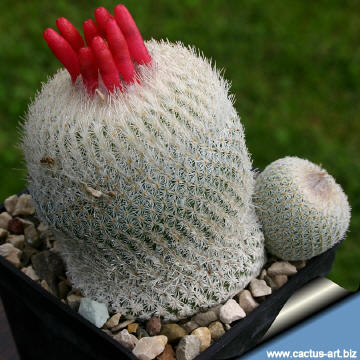 |
|
Although generally resembling
Mammillaria and superficially similar to
M. lasiacantha,
chloroplast
DNA evidence indicates that Epithelantha is
taxonomically isolated and more closely related to
Pediocactus and
Ariocarpus than to Mammillaria.
|
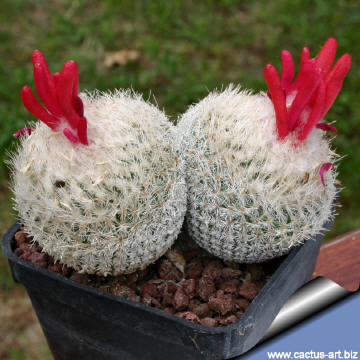
E. micromeris
SB256 SB256 Eddy co, NM. USA
|
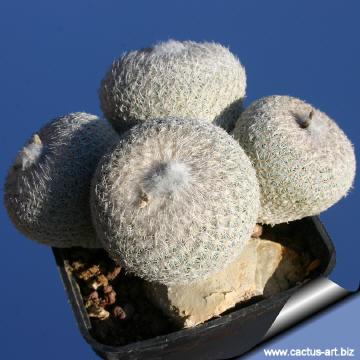
E. micromeris
SB125 Arteagas Canyon, Saltillo, Coahuila, Mexico
|
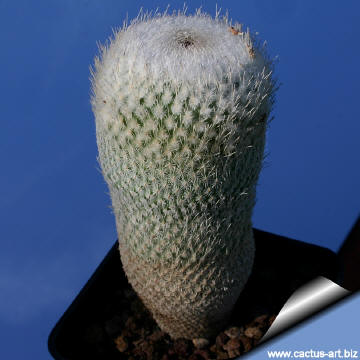 |
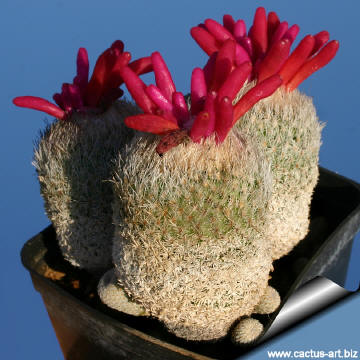 |
|
Advertising
|
|
|
|
|
|
Family:
Cactaceae (Cactus
Family)
Scientific Name:
Epithelantha
micromeris (Engelmann) F.A.C.
Weber ex Britt. & Rose 1922
Published in: Bois, Dict. Hort. 2. 804; et ex Britton & Rose, Cactac.
3. 93 (1922), 1898
Common names:
Button Cactus, ping-pong ball cactus, Common button
cactus
Basionym:
Mammillaria micromeris
Engelmann, Proc. Amer. Acad. Arts 3: 260. 1856 (as Mamillaria)
Synonyms:
-
Epithelantha micromeris var. micromeris (Engelmann)
F.A.C. Weber ex Britt. & Rose 1922
-
Epithelantha rufispina
-
Epithelantha micromeris var. rufispina
-
Epithelantha micromeris var. densispina
-
Epithelantha densispina
Bravo 1951
-
Epithelantha spinosior
C.Schmoll 1951
-
Epithelantha rufispina
Bravo 1951
-
Cactus micromeris Kuntze 1891
-
Mammillaria micromeris
1856
Distribution: USA - Arizona (Santa Cruz and
Cochise County) New Mexico (Hildago and Sandoval Co, From Sierra and
Chaves to Eddy Co), western Texas. Mexico (northern Chihuahua).
The
endemic Mexican
taxa have relatively large flowers like those of E.
bokei.
Habitat: Widespread in desert
grasslands and
woodlands from 500 to 1800m in
elevation. It grows on crevices, coarse gravel, cliffs, sedimentary
(rarely igneous)
substrates on hills and ridges in
the Chihuahuan
Desert; These cacti are normally found in small
clusters because the seeds fall nearby. Also wind, rain, and
wildlife help with the
dispersal of seeds.
Conservation status: Listed in
CITES
Appendix II
Etymology:
The
genus name
"Epithelantha"
derives from
the Greek word “Epi”
meaning “upon, on, at,
over”; the Greek word “thele”
meaning “nipple” referring to the tubercles, and
“anthos
”
meaning “flower”
describing flower position near tubercle apex, a reference to
the fact that the flowers doesn't originate between the nipple
as in the genus
Mammillaria.
(The genus name implies:
“flowers upon the tubercles”).
The
species name "micromeris" means: with
small parts or divisions.
|
|
|
|
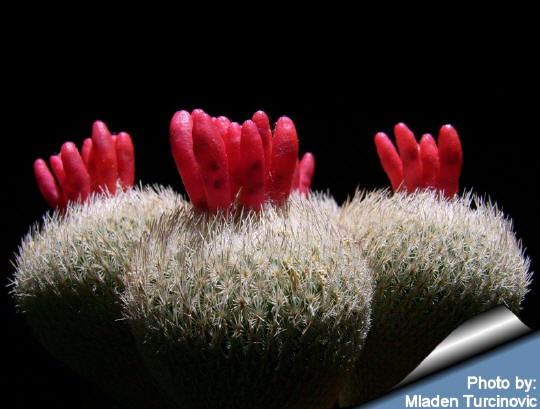
Photo and ©
copyright by
Mladen Turcinovic (Croatia)
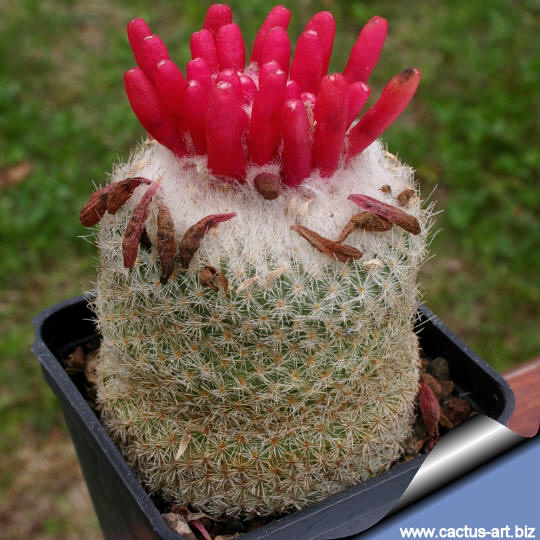
E. micromeris BZ58 Huasteca Canyon, Nuevo León, Mexico
Cultivation:
Although regarded as a choice and difficult plant, in
cultivation it is relatively easy. It needs a particularly
well-draining soil mix (rot prone). Water sparingly.
Frost Tolerance:
Depending on the variety, will handle -12° C (Temperature
Zone: USDA
8-11)
Sun Exposure:
Light shade to full sun
Propagation:
Seeds, offsets.
|
|
Photo of conspecific taxa,
varieties, forms an cultivars of Epithelantha micromeris:

 |
|